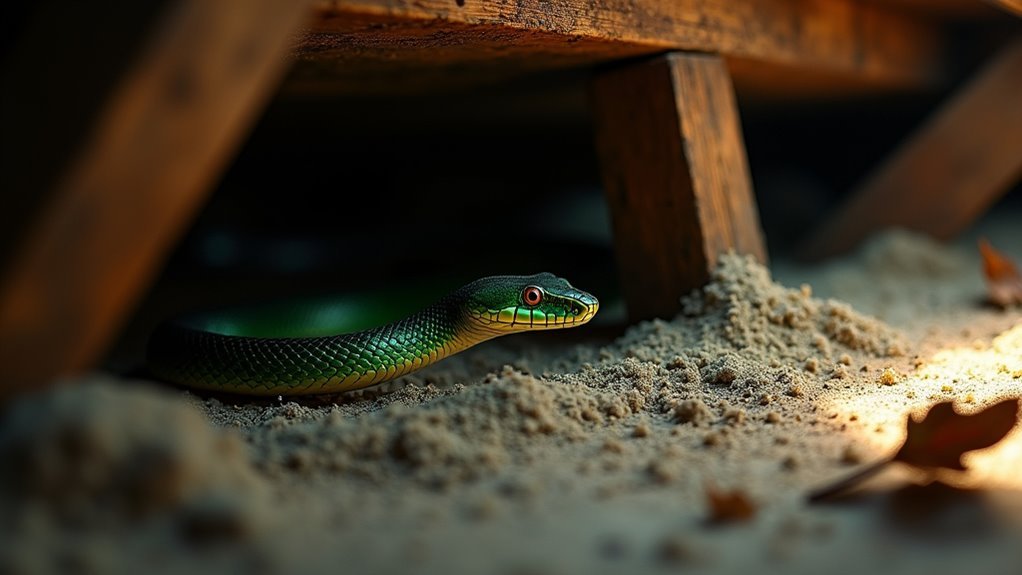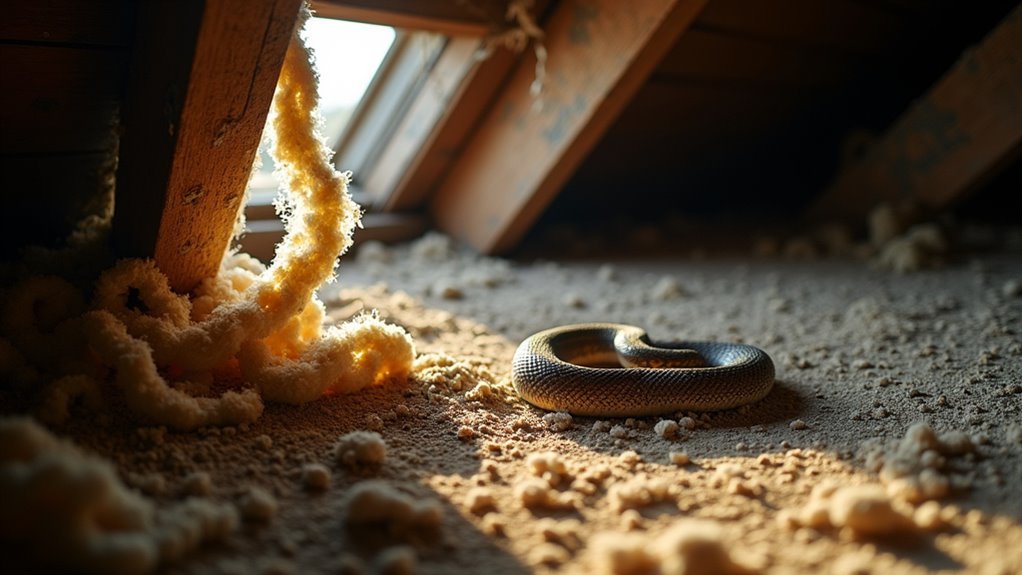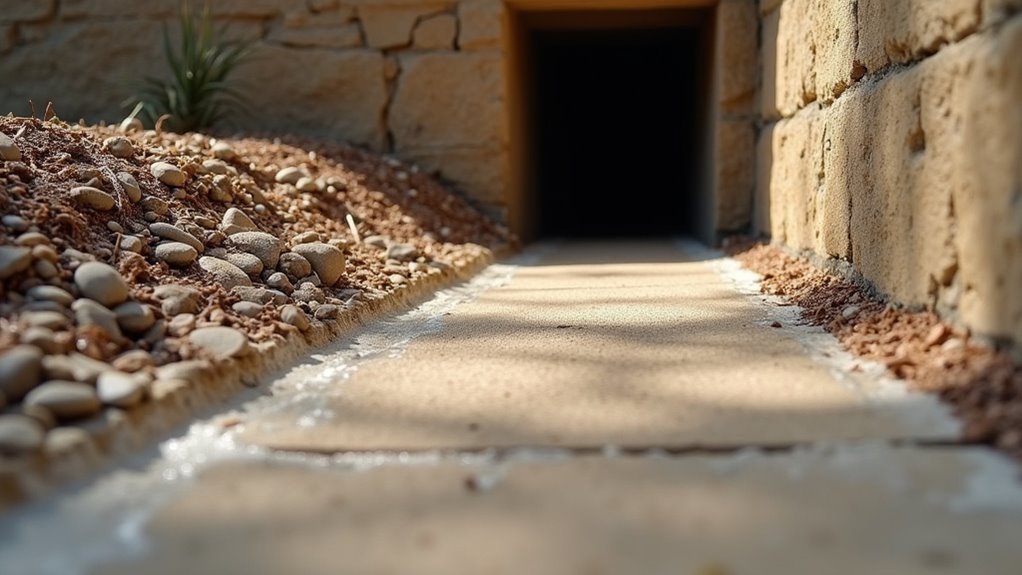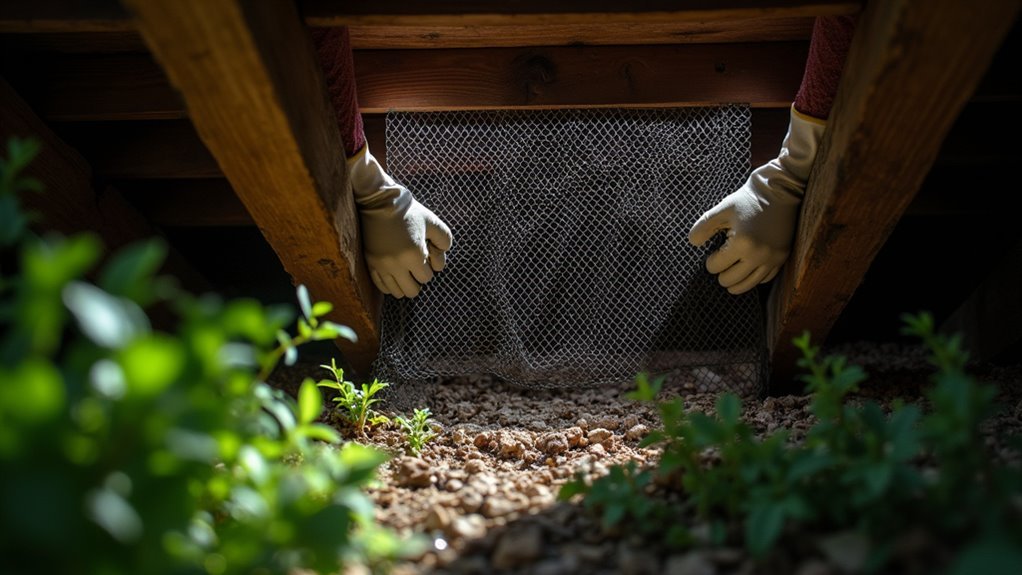You can keep snakes out of your attic and crawlspace by targeting what attracts them: food, moisture, and entry points. Seal foundation cracks and gaps around plumbing with caulk or expanding foam, then control rodent populations through proper food storage and regular pest treatments. Install dehumidifiers to maintain humidity below 60%, and use mesh barriers around vulnerable areas. Plant natural deterrents like marigolds around your property for additional protection. These extensive strategies will help you create an unwelcoming environment for unwanted serpentine visitors.
Why Snakes Choose Attics and Crawlspaces as Shelter

When temperatures drop or storms roll in, snakes instinctively seek out the warm, humid conditions that attics and crawlspaces naturally provide.
Snakes naturally gravitate toward the protective warmth and humidity that home attics and crawlspaces offer during cold weather.
These spaces mimic their natural habitats perfectly, offering ideal shelter from harsh weather and predators. Snakes are attracted to these dark, damp environments because they replicate the underground burrows and hidden crevices they’d typically inhabit in the wild.
Your attic and crawlspace become even more appealing when rodents are present. Since mice and rats serve as snakes’ primary food source, they’ll follow scent trails directly to these areas.
Small gaps and entry points make access simple, allowing snakes to slip inside undetected. Once they’ve found abundant food sources, they’ll often remain for extended periods, turning your home’s hidden spaces into their permanent residence.
Common Entry Points Snakes Use to Access Your Home
Understanding how snakes gain access to your home is crucial for effective prevention. Snakes can slip through surprisingly small gaps in your foundation—openings as narrow as a quarter inch provide easy entry.
Open vents and poorly sealed crawl spaces create direct pathways to your attic and interior areas. Pay attention to holes around plumbing and electrical lines entering your attic, as these often go unnoticed but offer perfect access points.
Broken or missing window and vent screens fundamentally invite snakes seeking shelter or food.
Your landscaping choices matter too—rock piles and dense vegetation near your foundation create convenient highways for approaching snakes.
Identifying Signs of Snake Activity in Hidden Areas

Even after sealing potential entry points, you’ll need to monitor your home for evidence that snakes have already taken up residence in hidden spaces.
Look for shed snake skins in crawlspaces or attics, as these indicate prolonged presence in the area. Check for tubular, chalky droppings that signal active snake activity.
Listen carefully for nocturnal sounds like hissing, slithering, or rustling within walls or concealed areas.
Don’t overlook signs of rodent activity, including droppings resembling brown rice grains or nests made from soft materials, as these attract snakes seeking food sources.
Regularly inspect for grease marks around walls and baseboards, which indicate rodent movement and may draw snakes to your home.
Early detection helps determine if professional snake removal services are necessary.
Eliminating Food Sources That Attract Snakes
Since snakes primarily hunt rodents, cutting off their food supply becomes your most effective defense strategy.
Start by sealing garbage promptly and storing food in airtight containers to prevent attracting rodents to your property. Remove bird feeders that inadvertently draw mice and rats, and keep outdoor eating areas spotless after use.
Proper food storage and clean outdoor spaces eliminate the rodent attractions that draw snakes to your property.
Regular pest control treatments greatly reduce rodent populations around your home. Consider hiring a pest control company for scheduled maintenance that targets mice and rats before they establish colonies in your attic or crawlspace.
Maintain your landscape by mowing grass short and clearing dense brush where rodents hide. Well-trimmed vegetation eliminates shelter for potential prey animals.
Sealing Foundation Cracks and Structural Gaps

You’ll need to thoroughly inspect your home’s foundation, walls, and exterior structure to identify even the smallest cracks and gaps that could serve as snake entry points.
Once you’ve located these openings, you can seal smaller cracks with caulk or expanding foam and cover larger holes with steel mesh or hardware cloth.
Consider hiring a professional inspector if you’re unsure about potential entry points, as their expertise can help you spot vulnerabilities you might’ve missed.
Identifying Entry Points
Foundation cracks as narrow as 1/4 inch can provide snakes with easy access to your attic and crawlspace, making a thorough exterior inspection your first line of defense.
You’ll need to systematically examine your home’s perimeter to locate potential entry points that snakes exploit.
Focus your inspection on these critical areas:
- Foundation perimeter – Check for cracks, gaps, and deteriorated mortar joints along the entire base of your home.
- Window and door frames – Look for gaps where frames meet siding or foundation materials.
- Utility penetrations – Examine areas where pipes, cables, or wires enter your home’s structure.
- Ventilation openings – Inspect crawlspace vents, dryer vents, and attic ventilation for missing or damaged screens.
Regular inspections help you stay ahead of structural changes that create new access opportunities.
Proper Sealing Materials
Once you’ve identified potential entry points, choosing the right sealing materials becomes critical for creating an effective barrier against snake intrusion.
High-quality caulk or foam sealant works best for filling small cracks and gaps in your foundation, effectively blocking tiny openings that snakes can exploit.
For larger gaps and vents, steel mesh or hardware cloth provides durable protection while maintaining proper ventilation.
Apply weatherstripping around doors and windows to seal edges tightly, eliminating access points for persistent pests.
When selecting proper sealing materials, make certain they’re moisture and decay-resistant to maintain long-term effectiveness.
Regular inspection and repair of these materials prevents even small openings from compromising your snake-proofing efforts.
Professional Inspection Benefits
While homeowners can handle basic sealing tasks, bringing in professional inspectors offers distinct advantages for thorough snake prevention.
Professional inspections utilize specialized tools and techniques to identify vulnerabilities you might miss with the naked eye.
Here’s what professional inspections deliver:
- Expert identification of foundation cracks and structural gaps that create entry points
- Precision sealing of openings as small as ¼ inch, which many snakes can squeeze through
- Comprehensive assessment of attics and crawlspaces where snakes seek shelter and food sources
- Long-term maintenance plans that guarantee your snake-proofing remains effective over time
Beyond snake prevention, addressing these structural weaknesses enhances your home’s overall integrity and safety, making professional inspections a smart investment for complete protection.
Managing Moisture and Humidity Levels
You’ll need to tackle moisture control since snakes are drawn to humid environments in attics and crawlspaces.
Start by installing proper dehumidifiers to maintain ideal humidity levels below 50%.
Then focus on improving crawlspace ventilation and sealing any moisture entry points from leaky pipes or roof damage.
Install Proper Dehumidifiers
Since snakes thrive in humid environments, installing a proper dehumidifier in your attic or crawlspace creates an inhospitable climate that’ll drive these unwanted visitors elsewhere.
These units effectively reduce moisture levels, making your home less attractive to both snakes and the rodents they hunt.
To maximize effectiveness with dehumidifiers:
- Maintain humidity below 50% to deter snakes and their prey from settling in your spaces
- Choose units with built-in humidistats for automatic adjustments without constant monitoring
- Check and empty water reservoirs regularly to prevent stagnant water from creating additional moisture problems
- Encapsulate crawlspaces first to create a sealed environment that enhances dehumidifier performance
Proper installation guarantees consistent moisture control, creating an environment snakes won’t find appealing.
Improve Crawlspace Ventilation
Crawlspace ventilation works hand-in-hand with dehumidification to create an environment that repels snakes naturally. When you improve crawlspace ventilation, you’re actively reducing the humidity levels that attract these unwanted visitors. Installing vents or exhaust fans promotes air circulation throughout your crawl space, preventing moisture buildup that creates ideal snake habitats.
| Ventilation Method | Installation Difficulty | Effectiveness | Maintenance |
|---|---|---|---|
| Foundation Vents | Easy | Moderate | Low |
| Exhaust Fans | Moderate | High | Moderate |
| Cross-Ventilation | Easy | High | Low |
| Sealed System | Hard | Very High | High |
Regular inspections guarantee your ventilation system functions correctly, while sealing gaps enhances airflow efficiency. Maintain humidity below 60% to discourage snake habitation effectively.
Seal Moisture Entry Points
While proper ventilation reduces humidity, sealing moisture entry points tackles the root cause of dampness that draws snakes into your home.
You’ll need to eliminate pathways where moisture infiltrates your attic and crawlspace to prevent snake infestations effectively.
Focus on these critical areas to seal moisture entry points:
- Foundation cracks and gaps – Apply waterproof caulk or hydraulic cement to block water seepage through concrete walls and floors.
- Pipe penetrations – Seal around plumbing entries with expanding foam or rubber gaskets to prevent moisture infiltration.
- Window wells and door frames – Install proper weatherstripping and verify drainage systems function correctly.
- Roof vulnerabilities – Repair damaged shingles, flashing, and gutters that allow water entry.
These steps will prevent snake-attracting moisture while protecting your home’s structural integrity.
Removing Hiding Spots and Clutter
Although snakes are skilled at finding small crevices and hidden areas to shelter, you can considerably reduce their presence by eliminating the clutter and hiding spots they seek.
Start by removing hiding spots in your attic and crawlspace, including old boxes, unused furniture, and any accumulated debris that creates dark, protected areas.
Focus on your property’s exterior as well. Stack firewood neatly and elevate it off the ground to prevent snakes from using it as shelter.
Regularly mow your grass and trim dense brush around your home’s foundation. Seal open areas under sheds and buildings where snakes might access for hiding.
Avoid rock piles in your landscaping, as they attract both snakes and the rodents they hunt.
Installing Physical Barriers and Snake-Proof Fencing
After clearing away clutter and hiding spots, you’ll need to create physical barriers that actively prevent snakes from accessing your home’s vulnerable entry points.
Installing mesh barriers around your home’s perimeter, sealing foundation gaps, and choosing the right fencing materials form the foundation of an effective snake exclusion system.
These strategic installations work together to create multiple layers of protection that stop snakes before they can reach your attics and crawlspaces.
Mesh Barrier Installation
One proven method for keeping snakes out of your attic and crawlspace involves installing mesh barriers or snake-proof fencing around these vulnerable areas.
A properly installed mesh barrier creates an impenetrable shield that blocks snakes from accessing your home’s most vulnerable entry points.
To guarantee maximum effectiveness, follow these essential installation guidelines:
- Choose durable materials – Use stainless steel or heavy-duty plastic mesh that can withstand weather elements and resist snake penetration.
- Install proper depth and height – Bury the mesh barrier at least 6 inches deep and extend it 12 inches above ground level.
- Maintain regular inspections – Check for damage or gaps that could compromise the barrier’s integrity.
- Combine with structural sealing – Fill existing cracks and gaps to enhance overall protection effectiveness.
Foundation Sealing Methods
When snakes find their way into your home’s foundation, they’re exploiting weaknesses that you can permanently eliminate through strategic sealing methods.
These foundation sealing methods involve installing steel mesh or heavy-duty plastic sheeting across gaps and cracks where snakes typically enter. You’ll want to focus on areas around plumbing, electrical lines, and vents since these represent common access points.
Use caulking or expanding foam for smaller openings to create an impenetrable barrier.
For perimeter protection, install snake-proof fencing that’s at least 3 feet high and buried 6 inches deep to prevent burrowing.
Professional-grade installation keeps snakes away most effectively, considerably reducing infestation risks.
Regular inspection and maintenance guarantee these barriers remain intact, as even tiny openings can compromise your defenses.
Perimeter Fencing Options
Three essential components make perimeter fencing your most reliable defense against snake intrusion: proper material selection, strategic installation depth, and precise height specifications.
You’ll need steel mesh or plastic sheeting to create an impenetrable barrier around your home’s perimeter.
Install your perimeter fencing using these critical specifications:
- Bury at least 6 inches underground to prevent burrowing underneath
- Extend 2 feet high above ground to stop climbing attempts
- Eliminate gaps larger than 1/4 inch since snakes squeeze through tiny openings
- Inspect regularly for damage to maintain barrier integrity
You’ll maximize effectiveness by combining perimeter fencing with foundation sealing and food source elimination.
This all-encompassing approach guarantees snakes can’t access your attics and crawlspaces through any potential entry route.
Using Natural Deterrents and Repelling Plants
While chemical repellents can be effective, natural deterrents offer a safer, eco-friendly approach to keeping snakes away from your attics and crawlspaces.
Strategic landscaping with repelling plants creates an unwelcoming environment for snake intrusion. Marigolds, lemongrass, and Mother-in-Law’s tongue form natural barriers around your property’s perimeter. Their presence discourages snakes from approaching entry points to your home’s upper and lower spaces.
You’ll find garlic, onions, and wormwood particularly effective since they emit odors that snakes find unpleasant.
For immediate results, soak rags in ammonia and place them near potential access areas. Create a potent spray using clove and cinnamon oil mixed in water, then apply it around your home’s foundation and entry points for enhanced protection.
Regular Inspection and Maintenance Practices
Beyond implementing natural deterrents, maintaining a proactive inspection routine forms the backbone of effective snake prevention.
A systematic, proactive inspection approach serves as the foundation for preventing unwanted snake encounters on your property.
You’ll need to establish a systematic approach that addresses potential entry points and environmental factors that attract these unwanted visitors.
Your regular inspection strategy should include these essential practices:
- Conduct bi-annual inspections of attics and crawlspaces, carefully examining areas for shed skin, droppings, or other signs of snake presence.
- Seal all entry points by identifying and closing cracks, gaps, or openings in foundations, walls, and ventilation systems.
- Remove debris and clutter from crawlspaces and surrounding areas to eliminate potential hiding spots.
- Control moisture levels using dehumidifiers and moisture-resistant insulation to create unfavorable conditions for snakes.
Schedule routine pest control services to manage rodent populations that typically attract snakes to your property.
When to Contact Professional Pest Control Services
Although prevention remains your first line of defense, certain situations warrant immediate professional intervention rather than DIY solutions.
If you spot a snake in your attic or crawlspace, contact a professional immediately for safe removal. Attempting to handle it yourself can be dangerous, especially since experts can identify potentially venomous species requiring specialized handling.
You should also contact a professional if you find shed snake skin or evidence of rodent infestations, as these indicate potential snake presence.
Professionals can address both issues effectively while eliminating attractants and sealing entry points promptly.
Since snakes can remain in your home for extended periods when food sources are available, many pest control companies offer preventive services ensuring long-term solutions.
Long-Term Prevention Strategies for Snake-Free Spaces
Since professional intervention addresses immediate threats, establishing robust long-term prevention strategies guarantees your property remains snake-free for years to come.
Maintaining control over your environment requires consistent vigilance and proactive measures.
Implement these essential strategies:
- Seal entry points – Inspect and close all foundation cracks, wall gaps, and openings, as snakes squeeze through surprisingly small spaces.
- Control moisture levels – Install dehumidifiers in crawlspaces to eliminate damp conditions that attract snakes seeking shelter.
- Maintain cleanliness – Regularly inspect attics and crawlspaces, removing snake skin or droppings to identify activity early.
- Create barriers – Install steel mesh fencing around your property’s perimeter and eliminate outdoor debris, tall grass, and wood piles that provide hiding spots.
Frequently Asked Questions
How Do I Keep Snakes Out of My Crawl Space?
You’ll need to seal all vents and gaps, install moisture-resistant insulation, use a dehumidifier, inspect regularly for snake signs, and eliminate rodents that attract snakes to your space.
What Can I Put in My Attic to Get Rid of Snakes?
You can place ammonia-soaked rags or clove and cinnamon oil mixtures in your attic to repel snakes. Remove clutter, seal entry points, and eliminate food sources like rodents to make the space unwelcoming.
Is It Normal to Have Snakes in Your Attic?
You shouldn’t expect snakes in your attic regularly, but it’s not unusual either. They’re attracted to rodents and warmth, especially during colder months when they seek shelter and food sources.
What Is the Best Snake Repellent for Under a House?
You’ll find ammonia-soaked rags work best under houses since they create strong odors snakes hate in confined spaces. Place them near entry points and replace regularly for maximum effectiveness against unwanted serpent visitors.
In Summary
You’ve got the tools and knowledge to keep snakes out of your attic and crawlspace for good. Stay consistent with your inspections, seal those entry points, and don’t let food sources accumulate. Remember, prevention’s always easier than removal. If you’re dealing with venomous species or can’t handle the situation yourself, don’t hesitate to call professionals. With these strategies, you’ll maintain a snake-free home year-round.





Leave a Reply